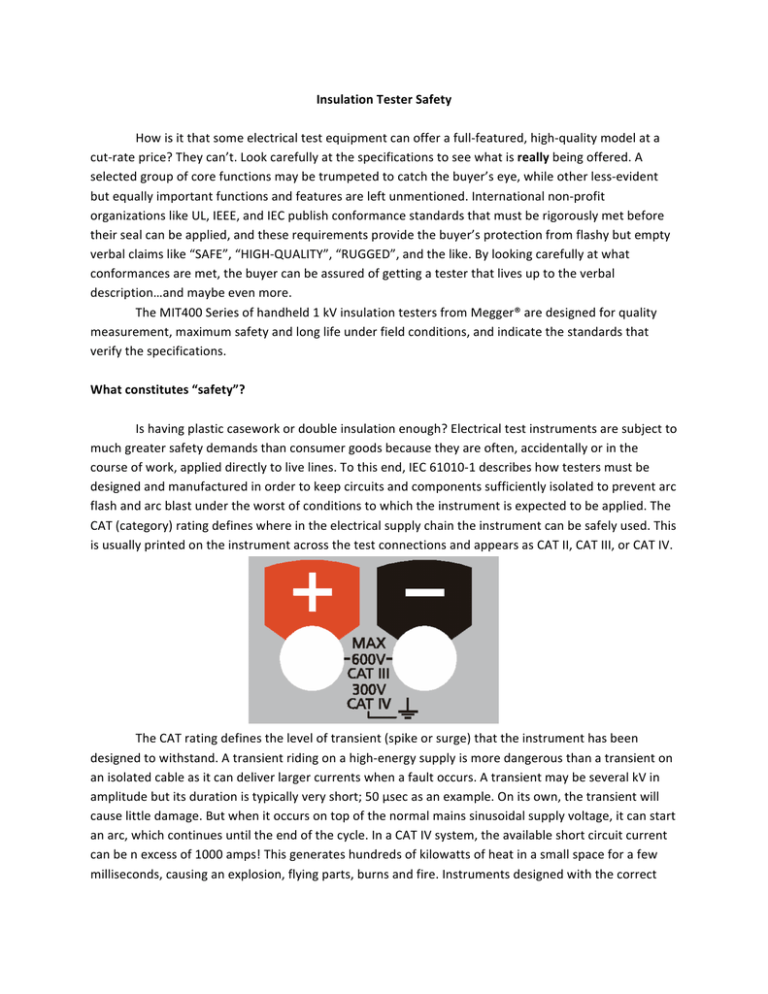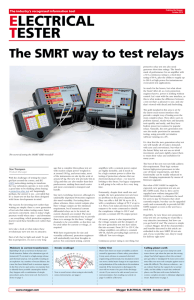Megger Insulation Tester Safety
advertisement

Insulation Tester Safety How is it that some electrical test equipment can offer a full-­‐featured, high-­‐quality model at a cut-­‐rate price? They can’t. Look carefully at the specifications to see what is really being offered. A selected group of core functions may be trumpeted to catch the buyer’s eye, while other less-­‐evident but equally important functions and features are left unmentioned. International non-­‐profit organizations like UL, IEEE, and IEC publish conformance standards that must be rigorously met before their seal can be applied, and these requirements provide the buyer’s protection from flashy but empty verbal claims like “SAFE”, “HIGH-­‐QUALITY”, “RUGGED”, and the like. By looking carefully at what conformances are met, the buyer can be assured of getting a tester that lives up to the verbal description…and maybe even more. The MIT400 Series of handheld 1 kV insulation testers from Megger® are designed for quality measurement, maximum safety and long life under field conditions, and indicate the standards that verify the specifications. What constitutes “safety”? Is having plastic casework or double insulation enough? Electrical test instruments are subject to much greater safety demands than consumer goods because they are often, accidentally or in the course of work, applied directly to live lines. To this end, IEC 61010-­‐1 describes how testers must be designed and manufactured in order to keep circuits and components sufficiently isolated to prevent arc flash and arc blast under the worst of conditions to which the instrument is expected to be applied. The CAT (category) rating defines where in the electrical supply chain the instrument can be safely used. This is usually printed on the instrument across the test connections and appears as CAT II, CAT III, or CAT IV. The CAT rating defines the level of transient (spike or surge) that the instrument has been designed to withstand. A transient riding on a high-­‐energy supply is more dangerous than a transient on an isolated cable as it can deliver larger currents when a fault occurs. A transient may be several kV in amplitude but its duration is typically very short; 50 µsec as an example. On its own, the transient will cause little damage. But when it occurs on top of the normal mains sinusoidal supply voltage, it can start an arc, which continues until the end of the cycle. In a CAT IV system, the available short circuit current can be n excess of 1000 amps! This generates hundreds of kilowatts of heat in a small space for a few milliseconds, causing an explosion, flying parts, burns and fire. Instruments designed with the correct category rating have sufficient clearance between critical parts to prevent an arc from creating the initial breakdown when a transient occurs. How is equipment evaluated against the electrical system? IEC 61010-­‐1 defines the design requirements for instruments that declare a specific category rating and specifies both the electrical and physical requirements. The electrical environment changes radically as current moves downstream of the source and risk diminishes. If test instruments are not rated for the specific environment, they become potentially lethal. Distribution lines are Category IV because the energy available from the utility supply is much higher near the transformer. Test equipment suitable for use in this environment must be rated CAT IV. By the time the voltage goes through the fuse panel into the house, the circuit impedance is higher and transients are damped, reducing the available energy in the transient. The ability of the test instrument to withstand this surge is less stringent, hence a Category III rating. The further down the supply you progress, the lower the protection a test instrument has to provide. At the socket or lighting outlet the circuit is rated CATII and items such as photocopiers, televisions, etc. can be considered as CATI environments, a category that has become largely obsolete. Most electricians’ testers will be rated to CAT II, or the better ones to CAT III. These instruments are not designed to be used on the higher-­‐energy CAT IV circuits. However, in reality this does occur, especially where voltage measurement ranges are included in the instrument functionality. But an insulation tester is for dead system testing? Absolutely, but the MIT400 Series can be used for voltage measurement and as such could be used for verification of supply voltage. In this application it is no different than a multimeter. Be careful to note the voltage spec that accompanies the CAT rating. This is the maximum rated voltage of the system to which the tester can be safely applied. Some manufacturers of test equipment will list the CAT rating only. This may or may not be adequate for your intended use. Is the risk really that great? Small transients (a few hundred volts) occur on supply systems most days of the year. Large transients (5 to 10 kV) do not occur very often. However, they are unpredictable, mostly caused by lightning strikes on overhead lines. Using a correctly rated instrument the chances of a dangerous breakdown are something like one in a million for every hour connected to the supply. Using one category less increases the chances of an accident by a factor of about 30. This means that if 100 operators are using instruments with wrong category ratings and they connect to live systems for one hour every day, 200 days a year, a dangerous situation is likely to occur once every 18 months! What about protection of the instrument? Far less critical than operator safety, but of great importance nonetheless, is protection of the test equipment itself. Through human error, insulation testers get connected across line voltage. This isn’t the brief, high-­‐voltage application of a spike, as occurs in arc flash, but the steady application of utility power. A test circuit meant to accommodate only milli-­‐amps of leakage current through insulation cannot stand up to power sufficient to drive machinery. A burn track is blazed across the pc board between the positive and negative terminals and the tester is rendered essentially useless. In a split second of inattention, the day’s work schedule can be ruined, an expensive proposition. But not with a Megger insulation tester! The MIT400 Series is voltage protected up to 50 V live-­‐line (75 V for telecom models). This means that innocuous low-­‐power “noise” sources and cross-­‐talk on telecom circuits will not cause nuisance disabling of the test function, but application of system power will be prevented from damaging the tester, even if the test button in engaged. Furthermore, both visual and audible warnings alert the operator to what is occurring and indicate the actual voltage that is externally applied. Isn’t there a danger when disconnecting at the conclusion of a test? The MIT400 Series goes a step further with operator protection. At the conclusion of a test, static voltage may be stored in the capacitance of the test item. Long runs of cable and large motor and transformer windings have enough built-­‐in capacitance to store a lethal charge when subjected to dc voltage for the duration of an insulation test. But immediately upon conclusion of the test (cessation of applied voltage by the tester), MIT400 Series models flash the display and beep to tell the operator there is static voltage on the test item, and display an exact measurement of that voltage. Furthermore, a resistive discharge circuit in the Megger instrument safely discharges the test item while the display monitors the discharge and indicates its progress to the operator. Redundant levels of safety keep the operator fully protected! All of the features mentioned and many other benefits only found on more advanced insulation testers are embodied in Megger’s latest MIT400 family of testers. The entry level MIT400 provides insulation testing at 250 V, 500 V and 1000 V, together with continuity testing and voltage measurement to CAT IV 600 V protection levels. The MIT410 adds 50 V and 100 V insulation tests, as well as fully automatic DAR and PI testing, while the MIT420 will measure up to 200 GΩ and adds insulation pass-­‐band settings and also internal storage of test results. At the top of the range is the MIT430, which not only stores test results but also allows them to be transferred to a PC via a Bluetooth wireless connection. With a Megger MIT400 Series tester, the operator gets all that could be desired in measurement range and accuracy PLUS a host of safety functions that protect both the instrument and the operator. Add to that numerous convenience features that make for both fast and reliable operation under rigorous field conditions, where time is money, and the instrument will pay for itself and then some. Check the specs!



